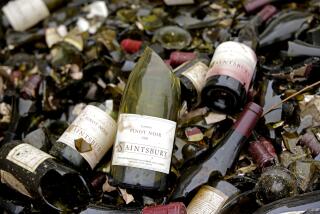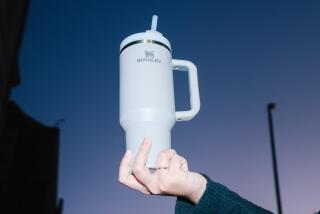Plastic bottles reshaping the wine trade
How about a bottle of the ’02 Chateau Plastique?
The ubiquitous 750-milliliter glass wine bottle is starting to get competition from a plastic upstart, both on retail shelves and at a few restaurants.
The bottles carry a “use by” date -- plastic doesn’t provide quite the same seal as glass -- and as such aren’t likely to find their way into the cellars of serious wine enthusiasts.
For those who aren’t as picky, however, the wine is likely to cost less. And oenophiles say that for wine that hasn’t, err, expired, the taste will be the same.
“The wine doesn’t know what package it is in,” said W.R. Tish, a wine educator who writes a blog called Wine Skewer. “It tastes the same whether it is in a plastic bottle, a plastic bladder inside a box, or a glass.”
At AKA a Bistro in St. Helena, in California’s Napa Valley wine country, owner Robert Simon will begin pouring a Cabernet Sauvignon out of plastic bottles this month for wine-by-the-glass customers.
Peralta Winery will sell him 1-liter plastic bottles for the same price as a 750-milliliter glass bottle. That means he can sell two extra glasses for about $7 to $8 each. And he won’t have to worry about the help breaking bottles.
“My decision will be based on the same factor as any wine -- taste,” said Simon, who also owns Bistro 45 in Pasadena. Simon plans to sell the wine there too. “Consumers only care about what’s in the glass.”
EnVino, a plastic wine bottle venture in Burlingame, Calif., notes that the containers weigh about one-eighth of a typical glass wine bottle and take up 20% less space. That enables winemakers to save fuel by shipping 30% more wine per truck, said Patrick Field, a partner in EnVino.
New Leaf Wine Co. in Napa is testing sales of wine packaged in the plastic EnVino bottles. A small test in Northern California’s Nugget supermarket chain last year “did great,” said Jason Taormino, president of New Leaf.
He would like to launch it in a broader selection of retailers and is looking for “a large distributor who is willing to work with us on this.”
Fred Franzia, owner of Bronco Wine Co., isn’t ready to go plastic just yet. He needs high-speed bottling for his $1.99 Charles Shaw wine -- also known as Two Buck Chuck -- and for now that means he needs heavier glass bottles.
“Plastic would just blow off the line. But it will come. They will figure it out,” Franzia said.
Ed Masciana, the Torrance businessman who owns Peralta Winery, plans to use plastic bottles for about a third of the 10,000 cases he sells annually, starting with Cabernet Sauvignon and Chardonnay.
But restaurants are his main target; he doesn’t think consumers are ready to buy wine in plastic bottles at stores.
At a restaurant, however, most people probably won’t even be aware that the glass of wine they ordered came from a plastic container.
“Unless I toss the bottle in your direction, you would never know it is isn’t glass, especially from across a darkened dining room,” Masciana said.
The bottles have a special layer designed to keep oxygen from permeating the container and destroying the wine. But it’s not the iron-tight seal that glass provides, so bottles will come with “use by” dates.
Spencer Collins, a Glendale graphic designer, said he would consider buying wine in a plastic bottle as long as it was modestly priced and he planned to drink it quickly.
“It depends on whether it was a $5 glass or $60 Cabernet,” he said.
Plastic containers are also used for the 187-milliliter single-serving wine bottles sold on commercial airlines and available at many supermarkets. But cost pressures are expected to accelerate the trend.
Boisset Family Estates, a Sausalito, Calif., wine company, started selling 1-liter plastic bottles of Fog Mountain Merlot to JW Marriott hotels for sale by the glass last month.
“The packaging was interesting, but what sold us on the wine was the quality and the taste,” said Laurie Goldstein, spokeswoman for Marriott’s food and beverage operations. The wine was holding its own with the hotel chain’s other offerings. “If it didn’t taste good no one would buy it,” Goldstein said.
Company President Jean-Charles Boisset notes that more than half the wine sold in America is consumed within months, if not weeks or even hours. Most wine sells for under $12 a bottle, making the added expense of handling and shipping glass bottles less defensible, he said.
The plastic bottles also cost less, but not as much as winemakers would like. Manufacturers are charging a little under $5 for a case of plastic wine bottles. That compares with $5 to $7 for glass. The industry expects the price for plastic to fall as the wine bottle production increases.
“Plastic will become the future of a big portion of wine packaging,” Boisset said. “The economics are amazing. It maintains the quality of wine and it is environmentally friendly.”
Still there’s no guarantee that this will be a success. Trader Joe’s tried selling a private label wine from Boisset -- a French Pont du Rhone -- earlier this year for $5.99 for a 1-liter bottle at its California stores but discontinued it after what it said was disappointing sales. It wasn’t clear if the problem was the plastic bottle or the wine.
Although the wine industry is steeped in tradition, plastic bottles aren’t the only change affecting consumers. Screw-top bottles -- once associated with cheap, sweet wines -- are finding their way onto more higher-end vintages.
The industry is adapting screw tops for wine that’s expected to be drunk within a short time frame, rather than stored in cellars for years. What’s more, the caps protect from TCA, or trichloroanisole, contamination. TCA is a pesky chemical byproduct of mold and chlorine that can destroy bottled wine.
Screw caps are frequently used now on German Rieslings, New Zealand Sauvignon Blancs and many California red and blush wines.
Given that consumers have already adapted to screw tops and sales of boxed wine are growing, many in the industry believe plastic will catch on.
Fog Mountain recently went on the shelves at Henry’s Farmers Market, the Irvine-based chain of natural and organic foods stores. It plans to feature the wine in the coming weeks, advertising it for $9.99 in its fliers and giving it a prominent floor position in its Southern California stores.
“Our consumers tend to care about the environment and want to be green, so we think it is going to be a hit,” said Janet Little, the chain’s spokeswoman.
But she acknowledged that it may take some “education” to get shoppers comfortable with drinking wine packaged in a plastic bottle.
“We would really like to have a tasting in our stores,” Little said, “but we don’t have a license for that.”
--
More to Read
Eat your way across L.A.
Get our weekly Tasting Notes newsletter for reviews, news and more.
You may occasionally receive promotional content from the Los Angeles Times.











